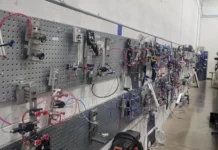by Mark Haynie, Novatec
 Central drying systems typically, but not always, are an integral part of a central conveying system. Central drying adds a new level of energy efficiency for processors because dryers can be moved off the production floor, and a single dryer is more efficient to operate than multiple dryers taking up space on the production floor.
Central drying systems typically, but not always, are an integral part of a central conveying system. Central drying adds a new level of energy efficiency for processors because dryers can be moved off the production floor, and a single dryer is more efficient to operate than multiple dryers taking up space on the production floor.
When a processor purchases a dryer and hopper combination, to protect against future capacity issues, they purchase a dryer larger than they really need – just in case. The ultimate consequence is that the production floor gets clogged with dryers and hoppers that are larger than required and then there are all those bulk boxes to feed material to the drying hoppers. So when it comes time to change material in that hopper, there are more labor and time issues. Since the dryer basically uses the same amount of energy whether it is drying 200 lb./hr. or 400 lb./hr. it’s pretty inefficient to have a dryer with a throughput capacity of 400-500 lb./hr. when drying 200 lb./hr. – yet that happens in a lot of plants.
A central drying system allows you to have “right-sized drying” all the time. A central dryer provides process air with a -40 degree dew point to multiple hoppers of varying sizes. Each hopper includes an adjustable process heater and a blower sized for the capacity of the hopper. This allows a single dryer to efficiently dry multiple materials with different drying requirements – at the same time. Material changeover is as easy as switching the pickup source from one hopper to another. In addition, maintenance is reduced because you don’t have multiple dryers spread around the plant with filters to be cleaned.
The two most common types of dryers used as central dryers are the dual bed (twin tower) desiccant bed dryers and desiccant wheel dryers. Most processors would agree that the desiccant wheel dryers have a smaller footprint and are more efficient that the dual bed dryers. A discussion on the features and benefits of each dryer would take up an entire blog so we’ll save that for another time.
Controls are another feature that makes central drying systems so beneficial. However, what type of controls to use on central dryers vary widely. There are still some dryers using microprocessor controls while other manufacturers have switched to touch screen controls and color touch screen PLC controls. There are also central drying system controls that allow temperature set points and alarm conditions to be entered from a central location for each hopper in the central system. Some controls include features that ensure materials are not under-dried or over-dried, which is important in the case of certain nylons and other moisture sensitive materials.
Another strong advantage of central drying is that you don’t have to be drying large quantities of material to benefit from this technology. There are central dryers in the industry with throughputs of up to 200 lb./hr. while the throughput capacity for central dryers can range up to 5,000 lb./hr.
Why You Should Consider a Central Drying System
- You are drying at multiple presses
- You process a wide variety of materials
- You make multiple material changes
- You need flexibility to serve needs of your customers
- You have too much finished product inventory Just in Time objective
- You need to reduce operating costs
- You are running out of space
- You have problems with inconsistent drying
Overcoming the Fear Factor
Just the mention of installing an integrated central drying or central conveying system strikes fear into the hearts of some processors who feel overwhelmed at the prospects of reconfiguring their process. But these types of systems have been installed in numerous plants with so many varying conditions that an experienced supplier and installer can accomplish the task with minimum interruption to the day-to-day manufacturing process and with a maximum of processor benefits. Most processors agree that the cost, time and labor benefits far outweigh any minor interruptions during the changeover and are well worth the investment.
Mark Haynie, dryer product sales manager at Novatec, Inc. earned his degree in chemical engineering from Virginia Tech and has worked for more than 30 years as a designer, product manager, sales engineer and sales manager for drying equipment used in the chemical and plastics industries. He can be reached at 410.789.4638.




